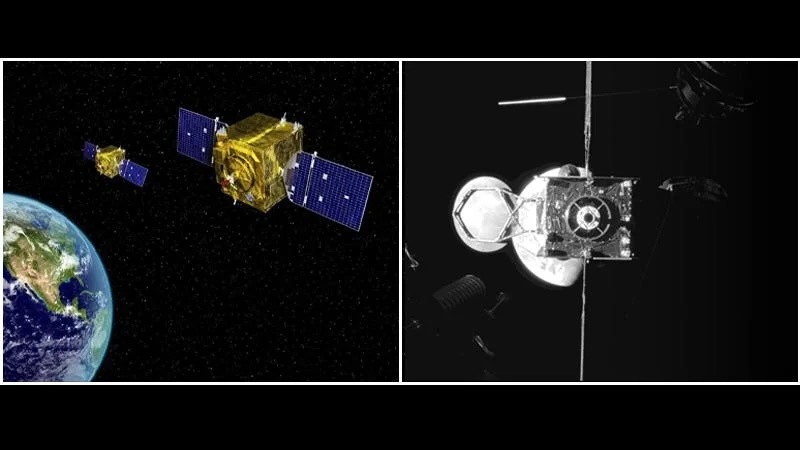3.10.2025

Northrop Grumman built the GSSAP spacecraft that are on orbit and is now developing satellites capable of in-space servicing. Credit: U.S. Space Force and Northrop Grumman
The U.S. Space Force wants its future space domain awareness satellites to look very different from their predecessors—it intends for them to be commercially derived and to be refuelable.
The service is shaping a new acquisition program called RG-XX to replace the Northrop Grumman-built Geosynchronous Space Situational Awareness Program (GSSAP) satellites with systems built by commercial space vendors. As the Space Force prepares a draft solicitation for release, potentially by year-end, one aspect is clear. “It absolutely has a refueling requirement,” said Maj. Gen. Stephen Purdy, Jr., acting Air Force assistant secretary for acquisition and integration.
While the service is funding technology demonstrations related to on-orbit refueling that are set to launch in the next couple of years, this would mark the first operational satellite program with such capabilities. “I mandated that and was very militant about that,” Purdy said at the Air and Space Forces Association’s Air, Space and Cyber Conference in National Harbor, Maryland, on Sept. 24.
The once-classified GSSAP spacecraft operate in near-geosynchronous Earth orbit (GEO) and can perform rendezvous and proximity operations (RPO) to maneuver near space objects of interest while collecting situational awareness data.
Those systems are constrained by a limited fuel supply and have aged since the first two were launched in 2014. Six have been launched to date, but the Space Force retired GSSAP-2 in 2023. United Launch Alliance is scheduled to carry GSSAP-7 and -8 on a Vulcan Centaur launch vehicle under the USSF-87 mission, and a final pair of satellites is expected to launch in 2027.
Adding a refueling capability to the next generation of neighborhood watch satellites would give the Space Force more freedom to maneuver in an increasingly competitive space environment. U.S. Space Command leadership has called for the Pentagon to fund in-space servicing technologies, including refueling.
Purdy acknowledged the combatant command’s desire for increased mobility, but he said the service has struggled to establish an actual program. RG-XX would be a way to “get our foot in the door” for refueling, he said.
That program is shaping up to be a departure from traditional acquisition processes in many ways. Purdy disclosed plans this year to replace the bespoke GSSAP spacecraft with commercially developed satellites. He pushed for the Space Force to sign off on a new acquisition strategy that reduced requirements for the program. As a result, RG-XX is expected to be unclassified and ready for foreign military sales, with multiple commercial vendors building satellites to be owned and operated by the Space Force.
Having multiple contractors could complicate the on-orbit refueling requirement, as different vendors will likely use different fuel, Purdy noted. The solicitation is being finalized, but vendors could perhaps supply their own refueler or the service could solicit bids for a contract to refuel spacecraft, he said.
Such systems are on the verge of viability. Northrop Grumman’s SpaceLogistics subsidiary announced in April that it had performed the first undocking between two commercial spacecraft in the GEO graveyard when its Mission Extension Vehicle (MEV) spacecraft decoupled with Intelsat’s IS-901 satellite after providing five years of life-extension services.
The subsidiary operates two MEVs, which are designed to attach to GEO satellites that are low on fuel, and it is building three next-generation servicers called Mission Extension Pods, SpaceLogistics President Robert Hauge said at the event on Sept. 23. Those pods are slated for launch in 2026 with the company’s Mission Robotic Vehicle, which features two robotic arms that could install the pod on a satellite along with a Space Force-funded refueling port, Hauge said.
The service also tapped Northrop Grumman in April to design and build a refueling payload called Elixir, integrate it onto a company ESPAStar spacecraft and attempt to refuel a demonstration client satellite in a test scheduled no earlier than 2028.
“Where we want to get to is the same place the Space Force is asking us, which is the ability to refuel in space,” Hauge said.
Several other demonstrations are on tap for the next couple of years. Astroscale U.S. is scheduled to perform two on-orbit refueling demonstrations in 2026 for the Space Force using its Refueler APS-R spacecraft to refill a U.S. military spacecraft in GEO.
The Defense Innovation Unit (DIU) is funding a fuel depot built by Orbit Fab for a Space Force demonstration called Tetra-5 planned for launch in 2026, during which an Astroscale U.S. spacecraft equipped with an Orbit Fab fuel port would dock with the associated depot.
DIU also has awarded a contract to Firefly Aerospace to demonstrate RPO and space domain awareness capabilities using its Elytra space vehicle on a mission due to launch in 2027. That test would position the company well for the RG-XX program, Firefly CEO Jason Kim said in a Sept. 23 earnings call. The Elytra spacecraft is being designed with high maneuverability, extensive fuel reserves and the ability to carry diverse payloads—all of which could be applied to RG-XX, Kim said.
Quelle: AVIATION WEEK
